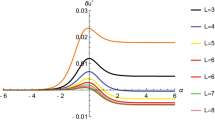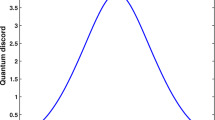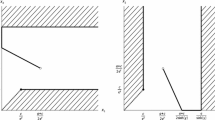Abstract
We apply Li et al.’s “minimal” quantization rules (Phys. Lett. A 306, 73, 2002) to investigate the quantum version of the Stackelberg–Bertrand duopoly, especially how the quantum entanglement affects the second-mover advantage in the Stackelberg–Bertrand duopoly. It is found that positive quantum entanglement is more favourable to the profit of the leader and destroys the second-mover advantage.



Similar content being viewed by others
Notes
In order to extend the classical Cournot duopoly to the quantum domain, Li et al. make use of two single mode electromagnetic fields [6]. The reason for choosing such fields is that they have a continuous set of eigenstates. The quantization scheme requires the Hilbert space used in the quantum game to have at least the same number of distinguishable states as that of the different classical strategies. As the strategic space of the classical Cournot game is a continuum, a Hilbert space with a continuous set of orthogonal bases is required. This “minimal” quantization scheme only extends the initial state to be an entangled state while keeping the strategic space unexpanded. Accordingly, the quantum game returns to the original classical game in the absence of entanglement.
References
von Neumannz, J.: Zur theorie der gesellschaftsspiele. Math. Ann. 100, 295 (1928)
von Neumann, J., Morgenstern, O.: Theory of Games and Economic Behavior. Princeton University Press, Princeton (1944)
See, for example, Bierman, H.S., Fernandez, L.: Game Theory with Economic Applications, 2nd edn. Addison-Wesley, USA (1998); Gravelle, H., Rees, R.: Macroeconomics, 2nd edn. Longman, UK (1992); Romp, G.: Game Theory: Introduction and Applications. Oxford University Press, New York, USA (1997)
Meyer, D.A.: Quantum strategies. Phys. Rev. Lett. 82(5), 1052 (1999)
Eisert, J., Wilkens, M., Lewenstein, M.: Quantum games and quantum strategies. Phys. Rev. Lett. 83(15), 3077 (1999)
Li, H., Du, J., Massar, S.: Continuous-variable quantum games. Phys. Lett. A 306, 73 (2002)
Obsborne, M.J., Rubinstein, A.: A Course in Game Theory. The MIT Press, Cambridge (1994)
Lo, C.F., Kiang, D.: Quantum oligopoly. Europhys. Lett. 64(5), 592 (2003)
Lo, C.F., Kiang, D.: Quantum Stackelberg duopoly. Phys. Lett. A 318, 333 (2003)
Lo, C.F., Kiang, D.: Quantum Stackelberg duopoly with incomplete information. Phys. Lett. A 346, 65 (2003)
Lo, C.F., Kiang, D.: Quantum Bertrand duopoly with differentiated products. Phys. Lett. A 321, 94 (2004)
Lo, C.F., Kiang, D.: To move first or not to move first? Quantum Inf. Process. 18, 335 (2019)
See, for example, Khan, F.S., Solmeyer, N., Balu, R., Humble, T.S.: Quantum games: a review of the history, current state, and interpretation. Quantum Inf. Process. 17, 309 (2018); Alonso-Sanz, R.: Quantum Game Simulation. Springer, Switzerland (2019)
Gibbons, R.: Game Theory for Applied Economists. Princeton University Press, Princeton (1992)
Dowrick, S.: Von Stackelberg and Cournot duopoly: choosing roles. RAND J. Econ. 17(2), 251 (1986)
Author information
Authors and Affiliations
Corresponding author
Additional information
Publisher's Note
Springer Nature remains neutral with regard to jurisdictional claims in published maps and institutional affiliations.
Appendix
Appendix
To derive the Nash equilibrium shown in Eqs. (5) and (6) from Eqs. (3) and (4), we first determine the reaction function of the follower who is supposed to react optimally to the price chosen by the leader and maximizes his or her profit. This can be achieved by requiring
Here, \({\overline{p}}_{F}\) is the reaction function of the follower. For different values of \(p_{L}\), the follower will optimize his or her profit with the price \({\overline{p}}_{F}\). Subsequently, against the optimal response of the follower, the leader maximizes his or her profit as follows:
Substituting \(p_{L}^{*}\) into Eq. (A.1), we obtain
With these optimal prices their profits are then given by Eqs. (7) and (8). Moreover, their counterparts in the quantized game shown in Eqs. (18)–(21) can be derived in a similar manner.
Finally, to obtain the asymptotic limits in Eqs. (22)–(25), one can first rewrite the expressions in Eqs. (20) and (21) in terms of \(\tanh \gamma \), and then apply the limit \(\tanh \gamma \longrightarrow \pm 1\) as \(\gamma \longrightarrow \pm \infty \).
Rights and permissions
About this article
Cite this article
Lo, C.F., Yeung, C.F. Quantum Stackelberg–Bertrand duopoly. Quantum Inf Process 19, 373 (2020). https://doi.org/10.1007/s11128-020-02886-0
Received:
Accepted:
Published:
DOI: https://doi.org/10.1007/s11128-020-02886-0




